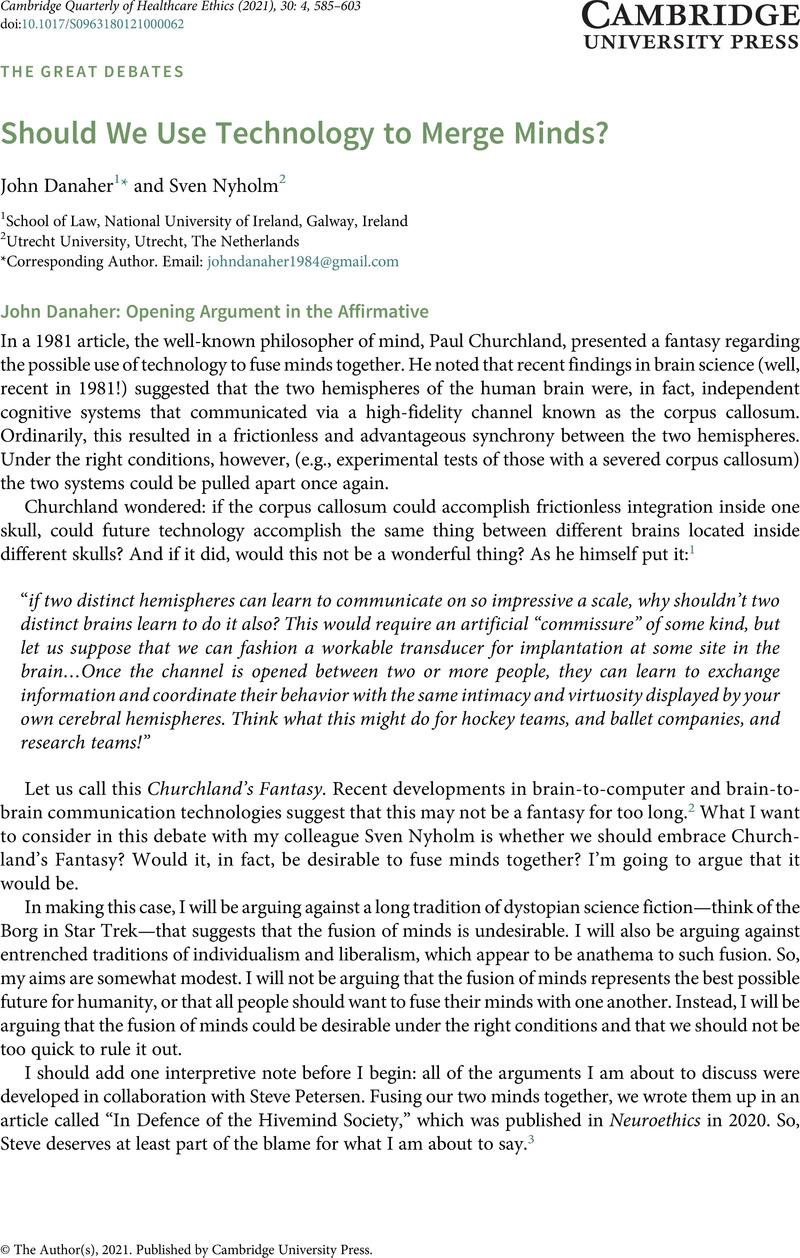Article contents
Should We Use Technology to Merge Minds?
Published online by Cambridge University Press: 27 October 2021
Abstract

- Type
- The Great Debates
- Information
- Copyright
- © The Author(s), 2021. Published by Cambridge University Press
References
Notes
1. Churchland, P. Eliminative materialism and the propositional attitudes. Journal of Philosophy 1981;78(2):67–90, at p 88.Google Scholar
2. For a popular introduction see Nicolelis, M. Beyond Boundaries: The New Neuroscience of Connecting Brains with Machines and How it Will Change Our Lives. New York: St Martin’s Press; 2011.Google Scholar
3. See Danaher J, Petersen S. In defence of the hivemind society, Neuroethics 2020. https://doi.org/10.1007/s12152-020-09451-7
4. Huebner, B. Macrocognition: A Theory of Distributed Minds and Collective Intentionality. Oxford: OUP; 2014.Google Scholar
5. Nozick, R. Philosophical Explanations. Cambridge, MA: Harvard University Press; 1981, at chaps. 5 and 6.Google Scholar
6. Danaher, J. Automation and Utopia. Cambridge, MA: Harvard University Press; 2019.Google Scholar
7. A recording of that event is available here: Automation and Utopia: John Danaher in Conversation with Brian D. Earp; available at https://www.youtube.com/watch?v=lTqo_zVMRgI&t=268s (last accessed 4 Feb 2021).
8. One worry about John’s idea of using technology to merge minds might be that it is unclear what kinds of technologies could be used to accomplish this feat. Here, however, I will mostly set technological worries aside and instead primarily focus on more conceptual and evaluative/normative issues.
9. https://philosophicaldisquisitions.blogspot.com/p/podcast.html (last accessed 4 Feb 2021).
10. See, for example, List, C, Pettit, P. Group Agency: The Possibility, Design, and Status of Corporate Agents. Oxford: Oxford University Press; 2011.CrossRefGoogle Scholar
11. Nyholm, S. Humans and Robots: Ethics, Agency, and Anthropomorphism. London: Rowman & Littlefield International; 2020. See, in particular, chaps. 3 and 6.Google Scholar
12. See note 11, Nyholm 2020, at chap. 6, p. 146
13. Dworkin, R. Justice for Hedgehogs. Cambridge, MA: Harvard University Press; 2011. Part of my inspiration for bringing up Dworkin’s discussion in this context comes from reading Anna Melnyk’s paper-in-progress “An Interpretation of Value Change,” which also relates Dworkin’s ideas to the issue of value change influenced by technological developments, particularly potential value changes related to worries about climate change and new energy sources.Google Scholar
14. Ahlin Marceta J. An individualist theory of meaning. Journal of Value Inquiry (in press).
15. Blanke, O, Metzinger, T. Full-body illusions and minimal phenomenal selfhood. Trends in Cognitive Sciences 2009;13(1):7–13 CrossRefGoogle ScholarPubMed. https://doi.org/10.1016/j.tics.2008.10.003; these experiments and others are discussed, along with their philosophical implications, in more detail in Metzinger, T. The Ego Tunnel: The Science of the Mind and the Myth of the Self. New York: Basic Books; 2009.Google Scholar
16. See, for instance, List, C, Pettit, P. Group Agency: The Possibility, Design, and Status of Corporate Agents. Oxford: Oxford University Press; 2011.CrossRefGoogle Scholar
17. See, for example, Veliz, C. Privacy is Power. London: Penguin; 2020.Google Scholar
18. See, for example, Pariser E. The Filter Bubble: What the Internet is Hiding from You. London: Penguin; 2011 Google Scholar; Lynch, MP. The Internet of Us: Knowing More and Understanding Less in the Age of Big Data. New York: Liveright; 2017.Google Scholar
19. See part 3 of Parfit, D. Reasons and Persons. Oxford: Clarendon Press; 1984.Google Scholar
20. See note 19, Parfit 1984.
21. Perhaps we should think of mind fusion as a “transformative experience” in L.A. Paul’s sense, which we cannot rationally evaluate before we have experienced it ourselves. See Paul, LA. Transformative Experience. Oxford: Oxford University Press; 2014.CrossRefGoogle Scholar
22. Originally described in Shackel, N. The vacuity of postmodernist methodology. Metaphilosophy 2005;36(3):295–320 CrossRefGoogle Scholar; Shackel referred to it as a “doctrine” rather than a “fallacy.”
23. See note 6, Danaher 2109.
24. Danaher, J. Welcoming robots into the moral circle: A defence of moral behaviourism. Science and Engineering Ethics 2020;26(4):2023–49.CrossRefGoogle ScholarPubMed
25. Danaher, J. The threat of algocracy: Reality, resistance and accommodation. Philosophy and Technology 2016;29(3):245–68.CrossRefGoogle Scholar
26. Smith, E. This is Shakespeare. London: Penguin; 2019.Google Scholar
27. Together with Steve Campbell, I have elsewhere explored the worry that modern life involves various different problems that threaten to make our lives the opposite of meaningful or “anti-meaningful,” as we put it, for example in Campbell, SM, Nyholm, S. Anti-meaning and why it matters. Journal of the American Philosophical Association 2015;1(4):694–711 CrossRefGoogle Scholar; Nyholm, S, Campbell, SM. Meaning and anti-meaning in life. In: Landau, I, ed. Oxford Handbook of Meaning in Life. Oxford: Oxford University Press; in press.Google Scholar
28. Many thanks to John Danaher and Tomi Kushner for helping me during the process of putting together my contributions to this exchange. In creating the written version of this debate, I have also been helped greatly by the discussion session that we had at the Neuroethics Network event in February 2021, which was chaired by David Lawrence. The comments made and questions asked during that session were very helpful, in particular those from Lawrence and those from Yves Agid and Philipp Kellmeyer.
- 1
- Cited by




